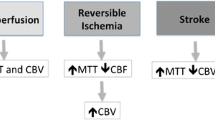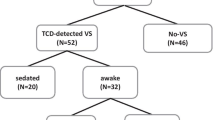Summary
A total of 226 measurements of cerebral blood flow (CBF) were performed in 96 postoperative patients with aneurysmal subarachnoid haemorrhage (SAH). The global CBF was significantly reduced in the first week after SAH, and the extent of the CBF reduction was less in the patients with good outcome than in those with fair/ poor outcome. The good outcome patients showed a progressive increase in CBF in the following 3 weeks. Although the CBF decreased further in the second week in some of those patients, it turned to a steady increase thereafter. On the other hand, in the fair/poor outcome patients CBF remained far below the normal control value for at least 3 months after SAH. When looking into the effect of age on CBF in the patients with good outcome, those in their thirties and forties had a significantly reduced CBF during the first 2 weeks, whereas in those in their fifties and sixties a significant reduction persisted for 3 months to 1 year after SAH. Management of the older patients needs special attention even if they are apparently in good clinical condition, since the CBF threshold to ischaemia is diminished.
Similar content being viewed by others
References
Bergvall U, Steiner L, Forster DMC (1973) Early pattern of cerebral circulatory disturbances following subarachnoid haemorrhage. Neuroradiology 5: 24–32
Dernbach PD, Little JR, Jones SC, Ebrahim ZY (1988) Altered cerebral autoregulation and CO2 reactivity after aneurysmal subarachnoid haemorrhage. Neurosurgery 22: 822–826
Gelmers HJ, Beks JWF, Journée HL (1979) Regional cerebral blood flow in patients with subarachnoid haemorrhage. Acta Neurochir (Wien) 47: 245–251
Géraud G, Tremoulet M, Guell A, Bes A (1984) The prognostic value of noninvasive CBF measurement in subarachnoid haemorrhage. Stroke 15: 301–305
Grubb RL Jr, Raichle ME, Eichling JO, Gado MH (1977) Effects of subarachnoid haemorrhage on cerebral blood volume, blood flow, and oxygen utilization in humans. J Neurosurg 46: 446–453
Heilbrun MP, Olesen J. Lassen NA (1972) Regional cerebral blood flow studies in subarachnoid haemorrhage. J Neurosurg 37: 36–44
Hunt WE, Hess RM (1968) Surgical risk as related to time of intervention in the repair of intracranial aneurysms. J Neurosurg 28: 14–20
Ishii R (1979) Regional cerebral blood flow in patients with ruptured intracranial aneurysms. J Neurosurg 50: 587–594
James IM (1968) Changes in cerebral blood flow and in systemic arterial pressure following spontaneous subarachnoid haemorrhage. Clin Sci 35: 11–22
Kawase T, Mizukami M, Tazawa T, Araki G (1981) Critical flow levels in cerebral ischaemia. II. Vasospasm following subarachnoid haemorrhage. No To Shinkei 33: 61–69(Jpn)
Knuckey NW, Fox RA, Surveyor I, Stokes BAR (1985) Early cerebral blood flow and computerized tomography in predicting ischaemia after cerebral aneurysm rupture. J Neurosurg 62: 850–855
Maroon JC, Nelson PB (1979) Hypovolemia in patients with subarachnoid haemorrhage: Therapeutic implications. Neurosurgery 4: 223–226
Matsuzaki T, Mizukami M. Kawase T, Tazawa T (1981) Angiographic vasospasm and regional cerebral blood flow in the cases of ruptured aneurysm. Correlation between vasospasm in the middle cerebral artery and delayed ischaemic hemiparesis. No Shinkei Geka 9: 1511–1516 (Jpn)
Meinig G, Ulrich P, Pesch R, Schürmann K (1985) nrCBF for the assessment of cerebrovascular spasm and the timing of angiography and operation in subarachnoid haemorrhage. In: Hartmann A, Hoyer S (eds) Cerebral blood flow and metabolism measurement. Springer, Berlin Heidelberg New York Tokyo, pp 172–179
Messeter K, Brandt L, Ljunggren B, Svendgaard NA, Algotsson L, Romner B, Ryding E (1987) Prediction and prevention of delayed ischaemic dysfunction after aneurysmal subarachnoid haemorrhage and early operation. Neurosurgery 20: 548–553
Meyer CHA, Lowe D, Meyer M, Richardson PL, Neil-Dwyer G (1983) Progressive change in cerebral blood flow during the first three weeks after subarachnoid haemorrhage. Neurosurgery 12: 58–76
Meyer JS, Ishihara N, Deshmukh VD, Naritomi H, Sakai F, Hsu MC, Pollack P (1978) Improved method for non-invasive measurement of regional cerebral blood flow by133Xenon inhalation. Part I. Description of the method and normal values obtained in healthy volunteers. Stroke 9: 195–205
Mickey B, Vorstrup S, Voldby B, Lindewald H, Harmsen A, Lassen NA (1984) Serial measurement of regional cerebral bloodflow in patients with SAH using133Xenon inhalation and emission computerized tomography. J Neurosurg 60: 916–922
Naritomi H, Meyer JS, Sakai F, Yamaguchi F, Shaw T (1979) Effects of advancing age on regional cerebral blood flow. Studies in normal subjects and subjects with risk factors for atherothrombotic stroke. Arch Neurol 36: 410–416
Pitts LH, MacPherson P, Wyper DJ, Jennett B, Blair I, Cooke MBD (1980) Effects of vasospasm on cerebral blood flow after subarachnoid haemorrhage. In: Wilkins RH (ed) Cerebral arterial spasm. Williams & Wilkins, Baltimore London, pp 333–337
Powers WJ, Grubb RL Jr., Baker RP, Mintun MA, Raichle ME (1985) Regional cerebral blood flow and metabolism in reversible ischaemia due to vasospasm. Determination by positron emission tomography. J Neurosurg 62: 539–546
Risberg J, Ali Z, Wilson EM, Wills EL, Halsey JH Jr (1975) Regional cerebral blood flow by133Xenon inhalation. Preliminary evaluation of an initial slope index in patients with unstable flow compartment. Stroke 6: 142–148
Ropper AH, Zervas NT (1984) Outcome 1 year after SAH from cerebral aneurysm. Management morbidity, mortality, and functional status in 112 consecutive good-risk patients. J Neurosurg 60: 909–915
Rosenstein J, Wang AD, Symon L, Suzuki M (1985) Relationship between hemispheric cerebral blood flow, central conduction time, and clinical grade in aneurysmal subarachnoid haemorrhage. J Neurosurg 62: 25–30
Sakaki S, Yano M, Kohno K, Kuwabara H, Matsuoka K (1983) Regional cerebral blood flow studies in patients with ruptured intracranial aneurysms. No Sotchu 5: 38–45 (Jpn)
Säveland H, Sonesson B, Ljunggren B, Brandt L, Uski T, Zygmunt S, Hindfelt B (1986) Outcome evaluation following subarachnoid haemorrhage. J Neurosurg 64: 191–196
Solomon RA, Post KD, McMurtry JG III (1984) Depression of circulating blood volume in patients after subarachnoid haemorrhage: Implications for the management of symptomatic vasospasm. Neurosurgery 15: 354–361
Voldby B, Enevoldsen EM, Jensen FT (1985) Regional CBF, intraventricular pressure, and cerebral metabolism in patients with ruptured intracranial aneurysms. J Neurosurg 62: 48–58
Yamagata S, Kikuchi H, Ihara I, Nagata I, Morooka Y, Naruo Y, Koizumi T, Hashimoto K, Minamikawa J, Miyamoto S, Mitsuno K, Matsumoto M, Yamazoe N, Akiyama Y (1988) Cerebral blood flow as a prognostic indication in subarachnoid hemorrhage. Neurol Med Chir (Tokyo) 28: 333–339 (Jpn)
Yamakami I, Isobe K, Yamaura A, Nakamura T, Makino H (1983) Vasospasm and regional cerebral blood flow (rCBF) in patients with ruptured intracranial aneurysm: Serial rCBF studies with the xenon-133 inhalation method. Neurosurgery 13: 394–401
Yamamoto M, Meyer JS, Naritomi H, Sakai F, Yamaguchi F, Shaw T (1979) Noninvasive measurement of cerebral vasospasm in patients with subarachnoid haemorrhage. J Neurol Sci 43: 301–311
Yonas H, Sekhar L, Johnson DW, Gur D (1989) Determination of irreversible ischaemia by xenon-enhanced computed tomographic monitoring of cerebral blood flow in patients with symptomatic vasospasm. Neurosurgery 24: 368–372
Zingesser LH, Schechter MM, Dexter J, Katzman R, Scheinberg LC (1968) On the significance of spasm associated with rupture of a cerebral aneurysm. The relationship between spasm as noted angiographically and regional blood flow determinations. Arch Neurol 18: 520–528
Author information
Authors and Affiliations
Rights and permissions
About this article
Cite this article
Matsuda, M., Shiino, A. & Handa, J. Sequential changes of cerebral blood flow after aneurysmal subarachnoid haemorrhage. Acta neurochir 105, 98–106 (1990). https://doi.org/10.1007/BF01669990
Issue Date:
DOI: https://doi.org/10.1007/BF01669990




